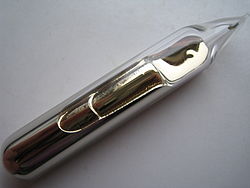Caesium is the chemical element with the symbol Cs
and atomic number 55. It is a soft, silvery-gold
alkali metal with a melting point of 28 °C (82 °F), which makes it
one of only five elemental metals that are liquid at (or near) room
temperature. Caesium is an alkali metal and has physical and
chemical properties similar to those of rubidium and potassium. The
metal is extremely reactive and pyrophoric, reacting with water
even at -116 °C (-177 °F). It is the least electronegative element
that has stable isotopes, of which it has only one, caesium-133.
Caesium is mined mostly from pollucite, while the radioisotopes,
especially caesium-137, are extracted from waste produced by
nuclear reactors.
What molten Caesium looks like.

Two German chemists, Robert Bunsen and Gustav Kirchhoff,
discovered caesium in 1860 by the newly developed method of flame
spectroscopy. The first small-scale applications for caesium have
been as a "getter" in vacuum tubes and in photoelectric cells. In
1967, a specific frequency from the emission spectrum of
caesium-133 was chosen to be used in the definition of the second
by the International System of Units. Since then, caesium has been
widely used in atomic clocks.
Since the 1990s, the largest application of the element has been
as caesium formate for drilling fluids. It has a range of
applications in the production of electricity, in electronics, and
in chemistry. The radioactive isotope caesium-137 has a half-life
of about 30 years and is used in medical applications, industrial
gauges, and hydrology. Although the element is only mildly toxic,
it is a hazardous material as a metal and its radioisotopes present
a high health risk in case of radiation leaks.
Atomic Clocks
A second was defined as: the duration of 9,192,631,770 cycles of
microwave light absorbed or emitted by the hyperfine transition of
caesium-133 atoms in their ground state undisturbed by external
fields. "13th General Conference on Weights and Measures,
1967"
Caesium-based atomic clocks observe electromagnetic transitions
in the hyperfine structure of caesium-133 atoms and use it as a
reference point. The first accurate caesium clock was built by
Louis Essen in 1955 at the National Physical Laboratory in the UK.
Since then, they have been improved repeatedly over the past
half-century, and form the basis for standards-compliant time and
frequency measurements. These clocks measure frequency with an
accuracy of 2 to 3 parts in 1014, which would correspond
to a time measurement accuracy of 2 nanoseconds per day, or one
second in 1.4 million years. The latest versions in the United
States and France are accurate to 1.7 parts in 1015,
which means they would be off by about 4 seconds since the
extinction of the dinosaurs 65 million years ago, and has been
regarded as "the most accurate realization of a unit that mankind
has yet achieved."
Caesium clocks are also used in networks that oversee the timing of
cell phone transmissions and the information flow on the
Internet.
PERIODIC TABLE

Check out this interactive Periodic Table.
Check out this Caesium video, quite the violent reaction. Prepared by
The University of Nottingham.